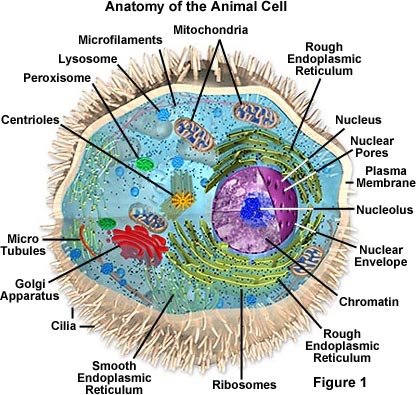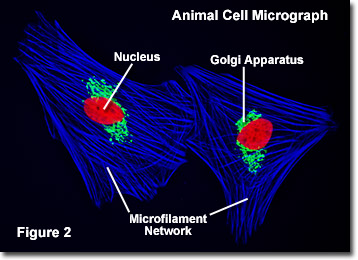What Does The Endoplasmic Reticulum Do In A Animal Cell Yahoo Answers
Creature Cell Structure
Animal cells are typical of the eukaryotic cell, enclosed by a plasma membrane and containing a membrane-leap nucleus and organelles. Unlike the eukaryotic cells of plants and fungi, fauna cells do not have a prison cell wall. This feature was lost in the distant by past the unmarried-celled organisms that gave rise to the kingdom Animalia. Nearly cells, both animal and plant, range in size between 1 and 100 micrometers and are thus visible just with the assistance of a microscope.

The lack of a rigid cell wall allowed animals to develop a greater variety of cell types, tissues, and organs. Specialized cells that formed nerves and muscles�tissues impossible for plants to evolve�gave these organisms mobility. The power to move well-nigh by the use of specialized muscle tissues is a authentication of the animal world, though a few animals, primarily sponges, exercise not possess differentiated tissues. Notably, protozoans locomote, but it is only via nonmuscular means, in effect, using cilia, flagella, and pseudopodia.
The fauna kingdom is unique amidst eukaryotic organisms considering most brute tissues are leap together in an extracellular matrix by a triple helix of protein known as collagen. Establish and fungal cells are spring together in tissues or aggregations by other molecules, such as pectin. The fact that no other organisms utilize collagen in this manner is ane of the indications that all animals arose from a common unicellular ancestor. Bones, shells, spicules, and other hardened structures are formed when the collagen-containing extracellular matrix between creature cells becomes calcified.
Animals are a large and incredibly various group of organisms. Making upward nearly iii-quarters of the species on World, they run the gamut from corals and jellyfish to ants, whales, elephants, and, of course, humans. Existence mobile has given animals, which are capable of sensing and responding to their environs, the flexibility to adopt many dissimilar modes of feeding, defense, and reproduction. Dissimilar plants, notwithstanding, animals are unable to industry their own food, and therefore, are ever directly or indirectly dependent on found life.
Near beast cells are diploid, meaning that their chromosomes exist in homologous pairs. Different chromosomal ploidies are too, however, known to occasionally occur. The proliferation of animal cells occurs in a variety of ways. In instances of sexual reproduction, the cellular process of meiosis is first necessary so that haploid daughter cells, or gametes, tin be produced. Two haploid cells then fuse to form a diploid zygote, which develops into a new organism equally its cells divide and multiply.
The earliest fossil prove of animals dates from the Vendian Period (650 to 544 meg years ago), with coelenterate-type creatures that left traces of their soft bodies in shallow-h2o sediments. The starting time mass extinction ended that period, but during the Cambrian Catamenia which followed, an explosion of new forms began the evolutionary radiation that produced most of the major groups, or phyla, known today. Vertebrates (animals with backbones) are not known to have occurred until the early Ordovician Menses (505 to 438 million years ago).

Cells were discovered in 1665 by British scientist Robert Hooke who first observed them in his rough (by today'south standards) seventeenth century optical microscope. In fact, Hooke coined the term "jail cell", in a biological context, when he described the microscopic structure of cork similar a tiny, bare room or monk's prison cell. Illustrated in Figure two are a pair of fibroblast deer skin cells that have been labeled with fluorescent probes and photographed in the microscope to reveal their internal structure. The nuclei are stained with a red probe, while the Golgi apparatus and microfilament actin network are stained green and blue, respectively. The microscope has been a cardinal tool in the field of jail cell biology and is often used to notice living cells in culture. Use the links below to obtain more detailed information nearly the various components that are establish in animal cells.
-
Centrioles - Centrioles are self-replicating organelles made up of nine bundles of microtubules and are constitute only in animal cells. They announced to help in organizing jail cell division, only aren't essential to the procedure.
-
Cilia and Flagella - For single-celled eukaryotes, cilia and flagella are essential for the locomotion of individual organisms. In multicellular organisms, cilia function to move fluid or materials past an immobile cell every bit well as moving a jail cell or group of cells.
-
Endoplasmic Reticulum - The endoplasmic reticulum is a network of sacs that manufactures, processes, and transports chemical compounds for employ inside and outside of the cell. It is connected to the double-layered nuclear envelope, providing a pipeline between the nucleus and the cytoplasm.
-
Endosomes and Endocytosis - Endosomes are membrane-leap vesicles, formed via a complex family unit of processes collectively known every bit endocytosis, and found in the cytoplasm of almost every animal cell. The basic mechanism of endocytosis is the opposite of what occurs during exocytosis or cellular secretion. Information technology involves the invagination (folding inward) of a cell's plasma membrane to surround macromolecules or other thing diffusing through the extracellular fluid.
-
Golgi Apparatus - The Golgi apparatus is the distribution and shipping department for the cell'southward chemical products. It modifies proteins and fats congenital in the endoplasmic reticulum and prepares them for export to the outside of the jail cell.
-
Intermediate Filaments - Intermediate filaments are a very broad course of gristly proteins that play an important role as both structural and functional elements of the cytoskeleton. Ranging in size from viii to 12 nanometers, intermediate filaments function every bit tension-begetting elements to help maintain prison cell shape and rigidity.
-
Lysosomes - The main role of these microbodies is digestion. Lysosomes break downwardly cellular waste products and debris from exterior the prison cell into unproblematic compounds, which are transferred to the cytoplasm as new cell-building materials.
-
Microfilaments - Microfilaments are solid rods fabricated of globular proteins called actin. These filaments are primarily structural in function and are an of import component of the cytoskeleton.
-
Microtubules - These straight, hollow cylinders are found throughout the cytoplasm of all eukaryotic cells (prokaryotes don't have them) and carry out a diversity of functions, ranging from transport to structural back up.
-
Mitochondria - Mitochondria are oblong shaped organelles that are found in the cytoplasm of every eukaryotic prison cell. In the brute prison cell, they are the master power generators, converting oxygen and nutrients into free energy.
-
Nucleus - The nucleus is a highly specialized organelle that serves as the information processing and authoritative center of the cell. This organelle has 2 major functions: information technology stores the cell's hereditary material, or Dna, and information technology coordinates the prison cell's activities, which include growth, intermediary metabolism, protein synthesis, and reproduction (cell partition).
-
Peroxisomes - Microbodies are a diverse group of organelles that are found in the cytoplasm, roughly spherical and bound by a single membrane. There are several types of microbodies but peroxisomes are the about common.
-
Plasma Membrane - All living cells have a plasma membrane that encloses their contents. In prokaryotes, the membrane is the inner layer of protection surrounded by a rigid prison cell wall. Eukaryotic animate being cells accept only the membrane to incorporate and protect their contents. These membranes also regulate the passage of molecules in and out of the cells.
-
Ribosomes - All living cells contain ribosomes, tiny organelles composed of approximately threescore percent RNA and 40 per centum protein. In eukaryotes, ribosomes are made of four strands of RNA. In prokaryotes, they consist of three strands of RNA.
In addition the optical and electron microscope, scientists are able to use a number of other techniques to probe the mysteries of the animal cell. Cells can exist disassembled by chemic methods and their private organelles and macromolecules isolated for study. The process of prison cell fractionation enables the scientist to prepare specific components, the mitochondria for case, in large quantities for investigations of their composition and functions. Using this approach, cell biologists take been able to assign various functions to specific locations within the jail cell. However, the era of fluorescent proteins has brought microscopy to the forefront of biology by enabling scientists to target living cells with highly localized probes for studies that don't interfere with the delicate rest of life processes.
BACK TO Cell Structure Dwelling house
Dorsum TO FLUORESCENCE MICROSCOPY OF CELLS
Questions or comments? Send us an email.
© 1995-2022 past Michael W. Davidson and The Florida State University. All Rights Reserved. No images, graphics, software, scripts, or applets may exist reproduced or used in whatsoever manner without permission from the copyright holders. Utilize of this website means y'all concur to all of the Legal Terms and Conditions ready forth past the owners.
This website is maintained by our
Graphics & Web Programming Team
in collaboration with Optical Microscopy at the
National High Magnetic Field Laboratory.
Last modification: Friday, November 13, 2015 at 02:eighteen PM
Access Count Since October 1, 2000: 6368269
Microscopes provided by:
Source: https://micro.magnet.fsu.edu/cells/animalcell.html
Posted by: williamsannot1974.blogspot.com

0 Response to "What Does The Endoplasmic Reticulum Do In A Animal Cell Yahoo Answers"
Post a Comment